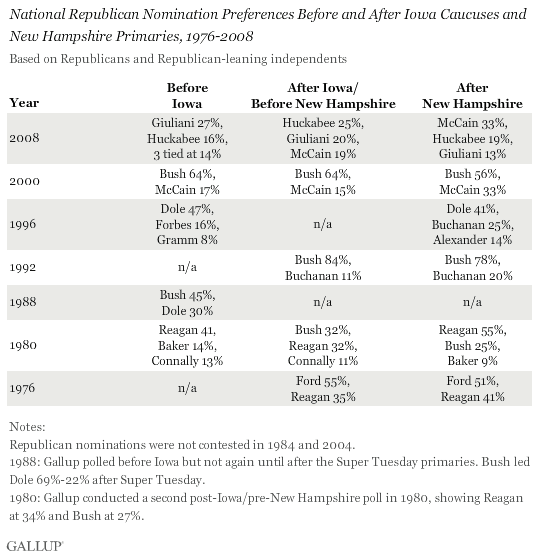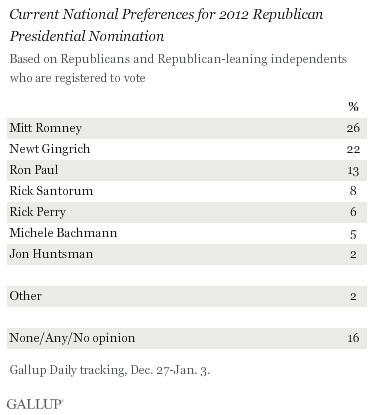PRINCETON, NJ -- In recent Republican presidential nomination campaigns, the results of the Iowa caucuses and New Hampshire primary have often made Republicans nationwide re-evaluate their preferences for the nominee, with the most change occurring in 1980 and 2008. Since 1976 -- the first year in the modern nominating era in which there was a competitive Republican contest -- the leader after New Hampshire has ultimately won the nomination.

Historical ���۴�ýdata show that the Iowa and New Hampshire contests usually alter the dynamics of the race in terms of the size of the front-runner's lead if not who the actual front-runner is. In all recent contests, the front-runner's lead shrank or disappeared after Iowa, after New Hampshire, or after both.
The Iowa caucuses helped produce a new co-leader in 1980 and a new leader in 2008. In 1980, George H.W. Bush tied Ronald Reagan nationally after Bush's surprise win in the Iowa caucuses. He was fourth nationally before Iowa, at 9%. In 2008, Mike Huckabee's Iowa victory moved him past Rudy Giuliani in national nomination preferences after Giuliani had led throughout 2007.
However, in both cases, the results of the subsequent New Hampshire primaries shifted preferences again. In 1980, Reagan regained a commanding lead after the New Hampshire primary. In 2008, John McCain emerged as the new front-runner after winning the New Hampshire primary and never trailed again, helped in part by his victory in the crucial South Carolina primary that year.
In fact, the national post-New Hampshire leader has continued to lead and gone on to win the Republican nomination each time, regardless of what occurred in other state primaries or caucuses. This has happened in each election year since 1972 rules changes shifted the power to choose the nominee away from party convention delegates and to voters in state primaries and caucuses.
The same has not held for Democratic nominating contests, with the lead changing hands at some point after New Hampshire in 1972, 1976, and 2008.
Romney Has Slight Edge Over Gingrich in Latest National Trial Heat
Gallup's latest national update for the 2012 nomination is based on interviewing conducted Dec. 27-Jan. 3, virtually all of which was before the results of Tuesday night's Iowa caucuses, won narrowly by Mitt Romney, were known.
���۴�ýshows Romney (26%) holding a slight edge over Newt Gingrich (22%), with Ron Paul a distant third at 13%. Rick Santorum, who lost to Romney by eight votes in Iowa, is next at 8%, although his numbers have climbed in recent days, averaging 12% in Monday and Tuesday interviewing.
Michele Bachmann, who ended her campaign Wednesday after a disappointing finish in Iowa, has 5% support.

The 2012 contest has proven to be , with four candidates -- Romney, Gingrich, Rick Perry, and Herman Cain -- leading or tied for the lead at one point or another.
In most Republican nomination contests, including 1988, 1992, 1996, and 2000, one candidate led throughout the nomination campaign. In 1976 and 1980, Ford and Reagan, respectively, led for the vast majority of those campaigns. Prior to this year, the 2008 nomination contest showed the most movement, with three different candidates leading at some point in the campaign.
Implications
With their strong showings in Iowa, Romney and Santorum can each expect his national poll numbers to rise in the coming days. However, history suggests the leader after New Hampshire may be in a better position to win the nomination. Romney is favored to win the New Hampshire primary, but voters there could reassess their choices after the Iowa results and Bachmann's departure from the campaign.
���۴�ýwill continue to track national Republicans' nomination preferences daily throughout the campaign, showing the effect of the Iowa results in the coming days and the effect of the New Hampshire results beginning in the middle of next week.
Survey Methods
Results for this ���۴�ýpoll are based on telephone interviews conducted Dec. 27, 2011-Jan. 3, 2012, on the ���۴�ýDaily tracking survey, with a random sample of 1,138 Republicans and Republican-leaning independents, aged 18 and older, living in all 50 U.S. states and the District of Columbia, who are registered to vote.
For results based on the total sample of Republican registered voters, one can say with 95% confidence that the maximum margin of sampling error is ±4 percentage points.
Interviews are conducted with respondents on landline telephones and cellular phones, with interviews conducted in Spanish for respondents who are primarily Spanish-speaking. Each sample includes a minimum quota of 400 cell phone respondents and 600 landline respondents per 1,000 national adults, with additional minimum quotas among landline respondents for gender within region. Landline telephone numbers are chosen at random among listed telephone numbers. Cell phones numbers are selected using random digit dial methods. Landline respondents are chosen at random within each household on the basis of which member had the most recent birthday.
Samples are weighted by gender, age, race, Hispanic ethnicity, education, region, adults in the household, and phone status (cell phone-only/landline only/both, cell phone mostly, and having an unlisted landline number). Demographic weighting targets are based on the March 2011 Current Population Survey figures for the aged 18 and older non-institutionalized population living in U.S. telephone households. All reported margins of sampling error include the computed design effects for weighting and sample design.
The questions reported here were asked of a random half-sample of Republicans for five nights on the ���۴�ýDaily tracking survey.
In addition to sampling error, question wording and practical difficulties in conducting surveys can introduce error or bias into the findings of public opinion polls.
For more details on Gallup's polling methodology, visit .
